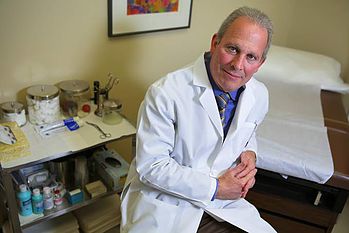
Santa Rosa urologist Michael Lazar has been traveling to Puerto Vallarta since 2007, though not exactly for sun and fun.
Lazar is part of a vanguard of urologists who are treating prostate cancer with a newly approved procedure in the United States that uses ultrasound to zap cancerous tissue. The procedure, known as high-intensity focused ultrasound, or HIFU, is used in more than 30 countries around the world. Until this fall, it had not been cleared for use in the United States.
Lazar, who has traveled to Mexico six to eight times a year since 2007 to treat American men diagnosed with prostate cancer, is now one of a handful of doctors expanding use of the procedure in treatment centers in the United States.
“There’s been one case done in Louisville, one case done in San Francisco by me, and that’s it in the United States at this point, because it just got approved to where we can be sold the machines, get the machines set up and get the centers going,” Lazar said this week as he sat in his small Sonoma Avenue office.
Lazar, who has practiced in Santa Rosa since 1983, has been conducting the procedure using the Sonablate, a HIFU device manufactured by SonaCare Medical. The device is the first to win approval from the U.S. Food and Drug Administration, and since then a similar device made by a French competitor has also been cleared by the FDA.
Lazar said treating prostate cancer with HIFU has a number of advantages over radiation and surgery, including reducing the possibility of side effects such as erectile dysfunction and incontinence.
The procedure is conducted by placing an ultrasound probe in the patient’s rectum, where it detects the exact dimensions of the tumor and zaps small areas only millimeters in size, focusing the treatment on the tumor rather than the entire prostate gland.
“We tell where we want to treat the whole gland or parts where the cancer exists,” Lazar said.
The probe sends ultrasound energy across the rectal wall to a specific target of cancerous tissue. As the ultrasound energy approaches the target, it becomes more and more focused, much like the sun’s rays through a magnifying glass, Lazar said. The focused high-intensity ultrasound raises the temperature of the tissue to 200 degrees, which kills the cancer as well as the normal tissue.
“It’s very precise,” Lazar said.
Technically, the FDA has not yet approved the HIFU device specifically for treating prostate cancer. Instead, it approved the procedure for tissue ablation, or removal, said John Linn, chief executive of HIFU Prostate Services, a newly formed company that partners with American urologists to purchase the Sonablate. Lazar, a partner with HIFU Prostate Services, is the new company’s medical director.
Since the treatment was approved in October by the FDA, the first HIFU procedure conducted in the United States took place in Louisville on Nov. 10 and the second was done in San Francisco on Nov. 18, the latter performed by Lazar. Prior to FDA approval, there were about 100 HIFU procedures conducted in the United States as part of clinical trials that led up to federal approval.
FDA approval to market HIFU devices for prostate treatment will require several more years of assessing the outcomes of these procedures, Lazar said.
For now, the device is marketed by the manufacturer as a minimally invasive method of removing cancerous tissue in the prostate gland, rather than treating prostate cancer. It’s a legal technicality that likely means little to patients.
Lake Country resident Said Najd, 75, underwent the procedure in San Francisco two weeks ago. Najd said he’s diabetic and likely would not have recovered from the surgical removal of his tumor. He said he’d recommend the procedure to other patients with prostate cancer.
“Everyday is getting better with the help of Dr. Lazar,” Najd said. “Normally, they have to cut you up and have the prostate out. This procedure is saving a lot of lives.”
Santa Rosa doctor journeys outside U.S. to practice new prostate cancer treatment
Najd, who lives on a ranch on Highway 29 between Lower Lake and Middletown, said he and his son are trying to start an Internet-based campaign to try to raise funds for other people who can’t afford to pay for the treatment. “Thanks to Dr. Lazar, I have a chance to recover from it,” he said.
Since 2004, about 4,000 American men have been treated with the Sonablate device outside the United States.
“We were treating up to 60 patients a month outside of the United States with U.S. urologists,” Linn said, adding that his company will have 12 domestic devices in use a year from now.
Lazar, who will continue to play a significant role in training other urologists in the use of the device, said that patients are likely to continue to travel outside the United States until more HIFU treatment centers are established across the country. The price tag for the procedure is about $25,000, a cost that most insurance companies or Medicare do not cover, he said. Many patients pay the entire cost.
But that cost includes physician travel costs and other expenses that would not normally be incurred if the treatments were done in the United States. Linn said the domestic cost of HIFU is actually less than that of radiation or surgery treatment.
“When you look at the cost of this procedure, it’s half the cost of surgery to the health care system and a third the cost of radiation,” Linn said, adding that private insurers are likely to catch on to the cost savings fairly quickly, and Medicare soon after that.
Private insurers will “come to that conclusion pretty quickly. … I think private insurers will do it before Medicare,” he said.

Comments are closed.